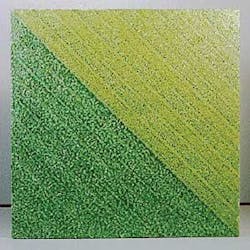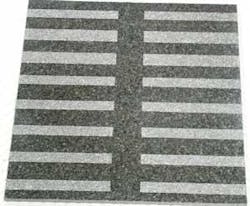Between a rock and a hard place
Lasers offer noise- and vibration-free processing in the construction industry
S. Wignarajah and Kaori Nagai
The use of lasers for processing materials used in civil engineering has been investigated for nearly four decades, but progress has been slow because of the high cost of laser processing and high power requirements for processing concrete and other materials, which are often thick or large in area. Since the late 1990s rapid advances have been made in the development of multi-kilowatt lasers such as high-power diode lasers and fiber lasers that has spurred renewed interest. Below we briefly describe some of the recent developments in the use of high-power lasers for cutting, drilling, and surface modification of materials such as concrete, mortar, and natural stones used in the civil engineering field.
Laser glazing
Techniques for laser glazing of natural stones and cement-based materials for use as wall paneling were developed in the early 1990s.1-4 A defocused, low power density beam (about 400 W/cm2) is used to melt the surface layer, and colors can be imparted to the glass layer by the addition of metallic ions (see Fig. 1). In the case of natural stones, metal ions in the form of aqueous salts are applied to the surface by brushing or other means before laser treatment. In the case of cement-based materials, small quantities of metal oxide powders are added to the mortar or concrete mix before the panel is cast. When the surface is melted by the laser, the glass layer takes on the color corresponding to the metal ion or oxide. Glazing by laser has the advantage that designs or color shades can be produced easily by varying the laser treatment parameters.
null
null
Laser decontamination
The feasibility of using lasers to remove the contaminated surface layer from concrete walls and floors in nuclear facilities is being investigated in many countries.5-9 The contamination usually exists only near the surface, the remaining thickness of the concrete being free of contamination. Removal of the contaminated surface layer (usually a few millimeters thick) would greatly reduce the volume of concrete to be disposed as contaminated waste during the decommissioning of these nuclear facilities. Some of the advantages of laser decontamination are: ease of remote operation that minimizes the time workers need to spend in the contaminated area, reduced generation of secondary waste, and reduced contamination of equipment. Proposed techniques of surface layer removal by laser irradiation include vaporization, spalling, and heat degradation.
Vaporization (ablation) of the surface layer can be achieved by scanning a focused laser beam over the surface of the concrete using relatively high power densities of the order of a few thousand watts /cm2, whereas a defocused beam with low power density (200 to 300 W/cm2) is employed for removal by spalling. In the latter case, the instantaneous evaporation of the water in the concrete just below the surface generates internal stresses that result in delamination and spalling of the surface layer. The disadvantage of removal by spalling is that the method is somewhat unstable and is limited to the first pass. Repeated scanning by laser of a previously spalled area produces little or no further spalling. For this reason, this method is effective for removing only shallow surface layers of about 2 or 3 mm in thickness.
A third method of removing the surface layer is to cause melting and heat degradation of the concrete near the surface by laser irradiation. The solidified glass layer and the heat-degraded zone below it are very brittle and can be easily removed by a mechanical tool (see Fig. 2). The feasibility of this method was successfully demonstrated in a nuclear facility in Japan in 1999 using a Nd:YAG laser robotic system. The process of laser melting and mechanical removal can be repeated until the desired thickness is removed.
Surface roughening
The use of a CO2 laser for scabbling and roughening the surface of granite stones used in buildings was demonstrated more than 10 years ago in Japan,10 as an alternative to the conventional method of roughening using jet burners. The advantages of laser scabbling compared to the burner process are: little or under-surface cracking, little or no loss of strength, no damage to the stone edges, and ease of producing surface designs similar to the example shown in Fig. 3.10, 11
More recent investigations in Germany, Spain, and Japan have demonstrated that lasers can also be used to engrave numerous tiny craters or thin tracks on granite and other stone surfaces to improve their slip resistance.11-13 The Fraunhofer Institute for Material and Beam Technology IWS in Germany has developed a process in which a pulsed laser beam is scanned across the surface of polished stones to produce thousands of micro-craters on the surface, producing improved slip resistance without losing much of the surface gloss. The method is being used in factories in Italy and Germany to produce slip-resistant stone flooring. A prototype of a mobile laser machine for slip-prevention treatment of existing floors has been developed.
Rock drilling
The Hokkaido Development Bureau in Japan has been investigating the feasibility of using lasers to drill holes in dangerous rock overhangs along roadsides in order to insert explosives for blasting and removal.14 The reason for using lasers to drill such holes is that no vibration and noise accompanies the drilling process. Actual outdoor field tests have been carried out using an 8kW Nd:YAG laser system.
Since 1997, the Gas Technology Institute (GTI) and its partners have been carrying out a long-term project on using lasers for rock drilling in oil well construction.15-17 Basic studies on laser-rock interactions have produced encouraging results, and GTI set up a new research facility in 2004 for evaluating the use of laser energy to improve various well construction and completion processes.GTI has acquired a 5.34kW Yb-doped fiber laser recently for carrying out further studies on rock drilling.18
Cutting concrete
Because of their low generation of fume and dust and ease of remote control, the use of lasers for cutting concrete in the decommissioning of nuclear reactor facilities is an attractive proposition.19 Figure 4 collates some of the reported laboratory test results on laser cutting of concrete. The energy input required for cutting rises rapidly when the thickness of the concrete exceeds about 10 cm due to the fact that expulsion of the viscous, molten material produced in the kerf becomes difficult with increasing depth. The maximum thickness that can be cut with a single pass is about 30 cm.
Recently a multi-pass method of cutting thick concrete using about 1 kW of laser power has been proposed in the UK.20 The method involves melting a shallow layer of the concrete and removing the solidified dross mechanically. By repeating laser melting and mechanical removal of the dross formed, it has been shown that even 50cm thick concrete can be cut. In another development, German researchers have demonstrated that the use of a pressurized cutting head is useful in expelling the viscous melt from the kerf, and have conceived a mobile cutting system based on this concept for on-site concrete cutting in apartment blocks.
Drilling concrete
In earthquake-prone areas, it is often necessary to strengthen existing concrete buildings (seismic retrofitting) by drilling holes in the concrete for holding steel anchors; however a major problem is the noise and vibration created by the use of conventional mechanical drills. Laser drilling of concrete is an attractive alternative because noise and vibration levels could be kept quite low. In the U.S., the Loma Linda University Medical Center and the Edison Welding Institute (EWI) have been developing laser drilling and cutting techniques for concrete, and it has been reported that drilling of concrete at an actual work site will soon be carried out using a prototype mobile laser system.21
Conclusion
One of the greatest needs in the construction industry is the development of techniques that allow noise and vibration-free processing of concrete and other materials at construction sites. Laser processing is capable of answering this need. It is encouraging to note that a number of new applications such as laser roughening of stone floors and laser drilling of concrete for seismic retrofit are ready or nearly ready for use on a commercial scale. The recent rapid progress in laser technology that has led to commercial availability of compact, multi-kilowatt diode lasers and fiber lasers is likely to accelerate the development of laser applications in civil engineering during the next decade.
References
- William C. Maurer, Advanced Drilling Techniques, Petroleum Publishing Co., Tulsa, Oklahoma, USA, p. 421-463, 1980.
- John F. Asmus, “Large-Scale Stone Cleaning by Laser” Western Association for Art Newsletter 13-1, Jan. 1991, at http://palimpsest.stanford.edu/waac/wn/wn13/wn13-1/wn13-102.html.
- Martin Cooper, “Recent Developments in Laser Cleaning,” quoted in http://www.buildingconservation.com/articles/laser/laser.htm.
- M. Hamasaki, “Experimental cutting of biological shield concrete using laser,” Proc. International Symp. on Laser Processing sponsored by the Institute of Laser and Chemical Technology, Tokyo, p.68-73, May 1987.
- Sugita et al., ”Application of laser for cutting concrete,” Concrete Journal 24-1, p.13-22, 1986 (in Japanese).
- H. Yoshizawa et al., “Study on laser cutting of concrete,” Journal of the Japan Welding Society, 120-1, p. 31-3637, 1989.
- Laser Handbook, published by the Sangyo Gijutsu Service Center, p. 302-305, 1994 (in Japanese).
- Y. Yokoyama et al., “Cutting of large-sized ceramic panels by CO2 laser,” Review of Laser Engineering 24- 2, p. 200-208, 1996 (in Japanese).
- Magarida Pires et al., “Marble Cutting by Laser,” SPIE 952, p. 622, 1988.
- K. Sugimoto et al., “Study on laser cutting assisted by water saturation of marble,” Review of Laser Engineering 24-2, p. 191-199, 1996 (in Japanese).
- S. Ohashi et al., ”Recent CO2 laser equipment and welding,” Welding Technique 43-11, p.60-65, 1995 (in Japanese).
- S. Wignarajah et al., “Laser Surface Treatment of Natural Stone and Cement Composites,” Taisei Technical Reports 24, p. 401-407, 1991.
- K. Sugimoto et al., ”Fundamental Study on Laser Treatment of Architectural Materials,” Proc. of ICALEO 1990, Boston, Nov. 1990.
- S. Wignarajah et al., ”Effect of Laser Surface Treatment on the Physical Characteristics and Mechanical Behaviour of Cement Base Materials,” Proc. of ICALEO 1992, Florida, Oct. 1992.
- H. Ichihara et al., ”Colored glass layer formation on cement-based materials by laser,” Review of Laser Engineering 22-4, 1994 (in Japanese).
- K. Nagai et al., “Study of effective use of rejected wood,” Proc. International Conference of the CIB Working Commission 70, October 1994, Tokyo, p. 1071.
- K.Tanaka et al., ”Microstructural changes of the surface layer of granite and durability after roughening treatment,” Proc. International Conference of the CIB Working Commission 70, October 1994, Tokyo, p. 591.
- L. Li et al., “Laser Fixing and Sealing of Radioactive Contamination on Concrete Surfaces,” Proc. LAMP ’92, Nagaoka, Japan, p.842, June 1992.
- H. Kamata et al., “Study on methods for decontaminating concrete surface by laser treatment,” Review of Laser Engineering 24-2, p. 182-199, 1996 (in Japanese).
- U.S Patent No. 05538764.
- European Patent No. EP0653762.
- Sivakumaran Wignarajah, Kenji Sugimoto, and Kaori Nagai, “Trends in high power laser applications in civil engineering,” Proc. SPIE Vol. 5777, p. 829-839, XV International Symposium on Gas Flow, Chemical Lasers, and High-Power Lasers, Prague 2004; Jarmila Kodymova; Ed.
An expanded reference list for this article can be accessed on the ILS Web site, www.industrial-laser.com.
Sivakumaran Wignarajah and Kaori Nagai are with the Technology Center of Taisei Corporation, Japan. This article was derived from an SPIE paper presented in Prague last year.22





